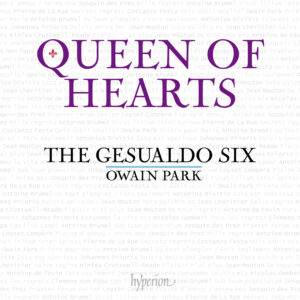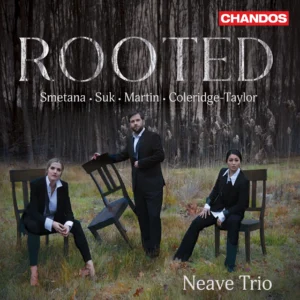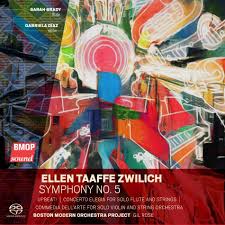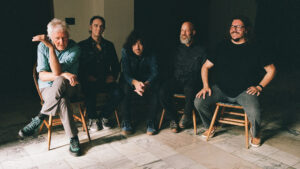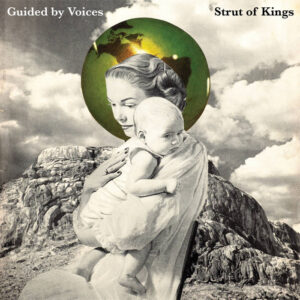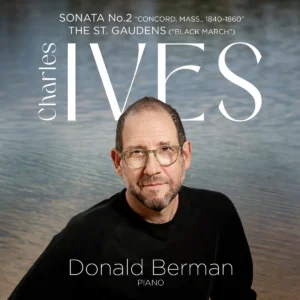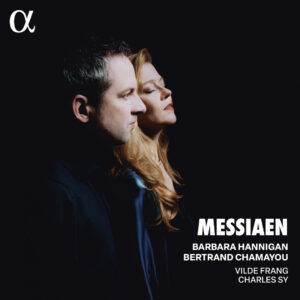The late-night Prom on August 9, presented by the London Sinfonietta and the Orchestra of the Age of Enlightment, conducted by Chloe Rooke, was devoted to a single work, Songs of Wars I Have Seen by Heiner Goebbels. The work was written in 2007 for those same two groups, on commission from the Southbank Centre, for the reopening of the Royal Festival Hall after its two year-long renovation. Songs of Wars I Have Seen is based on Gertrude Stein’s book detailing her life in occupied France during World War II. The ins and outs of how Stein and her companion Alice B. Toklas, two openly Jewish lesbians, survived more or less unscathed in a country controlled by Germans, where Jews were steadily being deported to concentration camps (examined in great detail by Janet Malcolm in an article in The New Yorker— https://www.newyorker.com/magazine/2003/06/02/gertrude-steins-war) is not dealt with in Goebble’s work directly, as it isn’t in Stein’s book. Here the subject matter is the concerns of day to day existence in a war-torn environment controlled by occupiers. The part of Stein’s narrative which is used in this work is also concerned with comparisons between the current war she is living through with earlier wars she has experienced, and even more with the presentation of wars and their effects in Shakespeare’s plays, which Stein and Toklas were reading aloud with friends during that time. These two time frames are presented in musical terms: the modern day concerns are presented with, as it were, “modern” music, while the discussion of the concern of wars in Shakespeare plays are represented with music of Matthew Locke’s incidental music for Shakespeare’s The Tempest, although that music may sometimes have a sort of overlay of mechanical noises, making the immediate situation inescapable. The text is always spoken by players, usually individually, but occasionally as a group. The players of modern instruments are not separated from the players of period instruments, but there is a separation of genders. In this performance the women were on the main part of the stage, surrounded by old style standing and table top lamps, as though at home. Around the top perimeter of the stage there was a line of male musicians, playing mostly brass and percussion instruments, who didn’t speak.
The quotidian nature of life in war is set off immediately by a discourse on honey and its replacement of sugar, which quickly becomes unobtainable in conditions of war. Later in the piece meetings with strangers and the fact of the full moon and the notion of going away or being taken away and the fact of pets and children in ones household and the differences of radio announcement in the broadcasters of different countries are also discussed, but all of these details of daily life are always considered against the usually unspoken consciousness of the potentially calamitous events that could be produced at any minute by the war in progress. The shape of the work is never articulated in a dramatic way, in keeping with the overarching concern with day to day life in wartime. But the progress of the work is sure and convincing and always engaging, and one is led eventually to considering that after a war, nobody wants to eat honey because it’s too sweet. The work ends with a statement that a war is over when everybody’s had enough of it, followed by a trumpet solo over the sound of prayer bowls, which is a combination of a lament and a sad fanfare.
Songs of Wars I have seen is a very intricate and demanding work, requiring not only very expert players playing very difficult and demanding music, but very very expert sound production as well. It’s hard to imagine a better performance that the one presented here. The recording of this performance can be heard on the BBC Sounds website (https://www.bbc.co.uk/sounds/play/m0021k0w) for a limited time.

Beaufort Scales is a new CD by Christopher Cerrone recently released by Cold Blue Music. Commissioned by the Lorelei Ensemble, this album explores the musical expression of the wind at sea in eleven beguiling vocal tracks. The composer writes that each of the pieces “…comment on the state of the weather at one point in time, serving as both a reprieve and a reflection upon the surrounding movements.” Developed in 1805 by British Admiral Sir Francis Beaufort and still in use today, the Beaufort Scale describes the velocity of wind using a value from 0 to 12 to indicate sea conditions from flat calm to hurricane force. The album also contains pieces based on texts from Herman Melville, F. Scott Fitzgerald, Anne Carson and the King James Bible. The eight treble voices of the Lorelei Ensemble bring a high level of virtuosity and a rare purity of tone color to all of the tracks in this album. Beaufort Scales is dedicated to the memory of Ingram Marshall.
The actual Beaufort Scale isn’t just numbers that represent wind speeds. For each number on the scale there is a corresponding description of typical wind and sea conditions. Beaufort Force 0, for example, includes the accompanying description: “Calm; Sea like a mirror. Smoke rises vertically.” A Force 7 wind is described as: “Near Gale; Sea heaps up and white foam from breaking waves begins to be blown in streaks along the direction of the wind.” The album tracks are numbered according to increasing Beaufort Force numbers and the track titles are taken from the relevant Beaufort descriptions of sea conditions. Most of the tracks combine a few of the Beaufort numbers together. Track 6, for example, is titled Steps 4, 5 & 6 Small, Moderate and Large Waves. Of the eleven tracks on the CD, seven are based on Beaufort numbers with the other four being interludes inspired by nautical texts. Track 5, for example, is titled Interlude 2: Herman Melville.
The tracks are generally short, from a little over 2:00 minutes to just under 5:30. All of the music is performed by the eight female voices of the Lorelei Ensemble accompanied only by subdued electronics realized by Chris Cerrone.. The early pieces begin gently according to their lower Beaufort numbers and the intensity gradually increases as the higher numbered tracks are heard. Prelude: Sea Like a Mirror, the first track, reflects Beaufort Scale 0. This begins in a quiet whispering sound, giving perhaps just the slightest suggestion of a breeze. This is soon accompanied by pure vocal tones in sustained harmonies that vary in volume. The singing is lovely with the words “Sea Like a Mirror” repeated in layered phrases. “Calm” is heard towards the finish as the sound of the lapping of small waves returns. Prelude: Sea Like a Mirror is a convincing realization of a calm, mirror-like sea surface.
Other tracks follow a similar pattern. Moving up the Beaufort Scale, track 8 is titled Steps 7, 8 & 9: Sea Heaps Up / Waves of Greater Length / High Waves. This opens with three voices sharply singing “Sea Heaps Up’ in a sort of round. There is a sense of urgency and alarm in the often dissonant harmony and strong articulation. “Waves of Greater Length” is heard in multiple voices with a lovely counterpoint. The singing here is precise and beautifully delivered.
The Interludes are heard as separate tracks between the Beaufort Scale numbers. Interlude 2: Herman Melville, although short at 2 minutes, is perhaps the most overtly nautical. A soft rushing sound is heard on the opening followed by a clearly spoken text: “The not yet subsided sea rolled in long, slow billows.” The spoken words continue – there is no music – and a second voice joins in repeating the words as if an echo. The language of Melville nicely evokes life aboard a 19th century sailing ship. The rushing sounds increase, just before the sudden ending. Interlude 4: Herman Melville, track 9, is just a little longer at 2:11. The text is again spoken but is now more intense, describing a violent typhoon. “The winds started blowing hard and the seas were rough…” Singing begins in gorgeous harmony with a feeling that is both eerie and beautiful. The treble voices here are impressive, as is the careful sound engineering by Mike Tierney and Scott Fraser that perfectly captures the pure tones.
Electromagnetic waves are, arguably, the building blocks of the universe. Beaufort Scales brings a vivid description of waves as we experience them in a natural, physical context resulting from ocean and weather. Another Cold Blue CD, released at the same time is Waves and Particles, by John Luther Adams and this explores the character of waves from an elemental perspective. That waves can be treated from an earthly macro perspective and also at the atomic level is a testament to the great expressive power of the music from these two composers.
Beaufort Scales is available directly from Cold Blue Music, Amazon Music and other retail outlets.
Tonight, the Locrian Chamber Players gives the New York premiere of Quintet 2 by Christian B. Carey.
Sequenza 21 readers know Carey very well through his insightful reviews of concerts and recordings in this publication. He is also a superb composer with a lengthy catalogue of varied works.
Quintet 2 is scored for oboe, clarinet, violin, cello and piano, and Carey wrote it for the East Coast Contemporary Ensemble, who commissioned it and premiered it in 2016. In his program note, Carey writes that much of his music – including this work – is based on the idea of labyrinthine structuring. “Quintet 2 deals with a spectrum of harmonic shadings, from triads to microtonal verticals with a great deal expressed in between. Likewise, the short melody at the beginning is offset by long passages of linear counterpoint. A number of rhythmic layers corruscate to create overlapping and frequently syncopated gestures.”
You can listen and follow along with the score on this YouTube recording.
Also on the program, music by Augusta Read Thomas, Oliver Knusson, Jeremy Beck, Jonathan Newman and the world premiere of “I Like Chocolate Ice Cream” by David Macdonald (me too, says the writer).
Performance Details:
August 15, 2024, 8 pm
Music from the Past Decade
Riverside Church
490 Riverside Drive, NY NY
Admission is free. A reception will follow.
Performers include: Calvin Wiersma and Conrad Harris, violins; Daniel Panner, viola; Chris Gross and Peter Seidenberg, cellos; Huan-Fong Chen, oboe; Benjamin Fingland, clarinet; Jonathan Faiman, piano; Jacqueline Horner-Kwiatek, mezzo-soprano
The BBC Prom on August 7 was presented by the BBC Philharmonic, conducted by John Storgårds. It featured Stefan Dohr as soloist in the Horn Concerto by Hans Abrahamsen, written between 2018 and 2019. The work is mostly a monologue by the soloist which is provided with a luminous and quite beautiful backdrop, sometimes reactive and interactive, and sometimes just a background, but always aurally compelling. Although the movements are designated by tempo, they are really differentiated more by the density of the, as it were, accompaniment than by the actually speed of the music. At the end of the work, the orchestra joins the soloist in the argument of the piece, before everything recedes into the glowing distance. The performance of the concerto was on the level that it deserved. It was all quite beautiful and effective.
The Abrahamsen was proceeded on the concert by Schumann’s Genoveva Overture and Pohjola’s Daughter by Sibelius, and was followed by an absolutely barn-burning and unforgettable performance of Tschaikovsky’s Fourth Symphony.
The Prom on August 9, which was presented by The BBC Symphony and their chief conductor Sakari Oramo, began with a performance of Mirage by Kaiji Saariaho, with Silja Aalto, soprano, and Anssi Karttunen, ‘cellist, as soloists. Mirage sets a poem by the Mexican shaman and poet Maria Sabina. (1894-1985). Sabina’s “poems” were actually trans-like utterances from her healing sacred mushroom ceremonies, called veladas. She is generally regarded as a masterful oral poet due to her presentation of traditional native Mexican themes in a uniquely person voice. For Saariaho, Sabina was an example of an exceptional female artist whose work was a powerful proclamation of her existence as a uniquely powerful creator. Mirage features the soprano voice singing Sabina’s text (in English, in a translation by Alvaro Estrada), but its way is prepared by the ‘cello part, which then intertwines with it, supported and amplified by the orchestra. In a way the work is a sort of recreation of the trance which produced the poem. The effect of the whole, with more forceful and less diaphanous and ethereal music than one usually expects from Saaariaho, emphasizes the concept, as articulated in the program notes by Pirkko Moisala, of “the identity of a mature woman and artist who has found her voice and accepted her calling.” It was completely compelling. The Saariaho was followed by performances of Mozart’s K. 271 Piano Concerto, with soloist Seong-Jin Cho, and Strauss’s Alpine Symphony.
The Prom on August 8, presented by the BBC Philharmonic, conducted by Anja Bilhmaler, was originally to have contained the first performance of beyond the beyond, by Sarah Gibson, which was a BBC Commission. At the time of her death from cancer in July of this year, the piece was incomplete. It is to be finished by her associate Thomas Kotcheff and will be performed at a later date. In its place, the program contained an earlier orchestral work of Gibson’s, warp and weft, of 2021. warp and weft is a tribute to the artist Miram Schapiro, whose work emphasizes what she called “femmage,” which is to say artistic work formerly practiced mainly by women, for instance decoupage and weaving, which were formerly considered “cafts” or “decorative art,” as opposed to the “high” arts, which were supposedly practiced mainly by men, and were, therefore, considered superior. In warp and weft, the weft, the horizontal axis of the loom, is associated with more melodic elements, and the warp, the vertical axis of the loom, deals with more harmonic aspects, and these two aspects basically alternate, finally, at the end of the piece, coalesce in a lively and appealing music. Gibson’s program note says that she imagined the piece as a sort of representation of Schapiro’s studio, “…a place full of color, with various materials and ideas, swirling around…” That is a fairly accurate description of the qualities of the work. In the concert the Gibson was preceded by the Beethoven Violin Concerto, with the admirable Tobias Feldman, as soloist, and followed by a compelling performance of the Brahms Fourth Symphony.
All of the proms are available for about sixty days after the date of the concert, on the BBC Sounds site, https://www.bbc.co.uk/sounds/brand/b007v097.
Queen of Hearts
Gesualdo Six, Owain Park, director
Alasdair Austin, countertenor (final track only)
Hyperion Records, 2024
On Queen of Hearts, the low male vocal ensemble Gesualdo Six explores pieces devoted to queens, both the Virgin Mary (in her guise as Queen of Heaven), and queens from England and Continental Europe during the renaissance era. Some of the selections blur identities, linking the saintly actions of earthly monarchs with those of Mary.
The Song of Songs, from the Hebrew Bible, has an interesting place in both sacred and secular music of the Renaissance. In liturgical pieces, it is an insertion that venerates the Virgin Mary. In secular motet-chansons, it is often incorporated to make a connection between virtuous secular queens and Mary. As is their usual mode of operations, Gesualdo Six present a well-researched and musically inspired program. The eminent musicologist Guy James prepared editions of the music sung on Queen of Hearts, making it a bespoke collection that reflects the most recent and respected editorial trends.
The motet-chanson, particularly the regretz chansons, are a pivotal part of the program of Queen of Hearts. In the regretz genre, the beloved’s heart is broken because the desired one doesn’t reciprocate their affection or they aren’t available to each other. As James discusses in his excellent liner notes, the first regretz chansons were dedicated to Margaret of Austria, who had them collected in a large songbook, then called a chansonnier. Secret regretz, by Pierre de la Rue, begins in duet textures, eventually fanning out into four-voice polyphony. The poem’s author refuses to be defeated, asking for aid from fellow poets to raise his spirits. This response is against the grain of many regretz texts, suggesting that the genre didn’t cohere at first, exploring various themes before settling on just a few.
Several regretz chansons were dedicated to Anne of Brittany, who throughout her life had a series of relationships end in heartbreak. Jean Mouton’s De tous regretz was likely written while the composer was at Anne’s court. Gesualdo Six plays up the antiphonal passages with a slight accelerando, while liquescent legato lines provide the piece’s moving conclusion.
Antoine de Févin is represented by Fors Seulement, with tight upper duet constructions offset by registrally dispersed lower voices. There are multiple settings that honor “Gentle Févin” after his passing. It is speculated that Dulcis amica dei by Johannes Prioris might have been one. The piece’s melody was popular enough to be used by other composers at the French court. Another piece by Prioris, this one likely dedicated to Anne of Brittany upon her passing, Consommo la vita mia, is even more attractive, with each phrase beginning with slowly articulated melodic lines and concluding with achingly slow. chordal descents. Prioris should be better known, and it is typical of Gesualdo Six’s programming that they include such composers alongside those more frequently programmed. Only one composer from Italy appears on Queen of Hearts, but Costanzo Festa’s Quis dabit oculis is a riveting extended motet that also mourns the death of Anne. Its doleful chords and a proto-fugue are given an expressive performance by the ensemble.
Anne Boleyn’s songbook contained a number of pieces by Joquin, in addition those by other continental composers. Josquin’s Mille Regretz is perhaps the most popular of the genre. One can readily hear why; it is exquisitely well-constructed, with an initial architecture of leaps eventually filled in to make for a seamless conclusion. Praeter rerum seriem is a Marian motet with canons, beginning from the bass, with text describing the visitation of Mary by the Holy Spirit. The second section begins with an upper duet that then accumulates, top-down this time, into six-part writing. A favorite of mine from the Boleyn songbook is Antoine Brumel’s setting of a devotion to Mary, Sub tuum praesidium. Homophonic duets in the upper voices are juxtaposed with polyphony that begins its rise from the lowest voices. The resulting harmonies are gorgeous.
Two new pieces were commissioned for Queen of Hearts. One is by Gesualdo Six’s director, Owain Park, Prière pour Marie. The text is a prayer that was said to have been uttered by peasants about Mary Tudor when she was glimpsed traveling towards her wedding to Louis XII. “Mary on earth, Mary in the sky.” Park has a fine command of the polychords and chromatic tonal shifts frequently found in 21st century choral music. The piece’s declamation combines stacked verticals, and canons found amid other voices in free counterpoint. Its mood is portentous, as if the peasants have, by analogizing one queen to another, felt as if they have seen a divine vision. Plaisir N’ai plus by Nifea Cruttwell-Reade, is full of harmonic surprises, especially ones that resolve curiously against a pedal tone. In places, it appears that Cruttwell-Reade is repurposing the chromatic cadences that occurred in the renaissance to function in their own polytonal idiom.
The recording ends with one of the great pieces of the middle Renaissance, the Song of Songs setting Ego flos campi by Clemens non Papa. A seventh singer, the countertenor Alasdair Austin, is added to the performance. Perhaps Clemens’s best known piece, it is a beautiful treasure. Gesualdo Six plus one give a memorably expressive performance of it.
Queen of Hearts is both curated and performed with exquisite care. It is one of my favorites thus far of 2024.
Christian Carey
Neave Trio
Rooted
Chandos Records (2024)
Neave Trio – violinist Anna Williams, cellist Mikhail Veselov, and pianist Eri Nakamura – has recently made several imaginative recordings for Chandos. Rooted is influenced by traditional music and by Antonín Dvořák, who brought the concept of using your country of origin’s folk music in concert works to the United States and, in the case of one of the programmed composers, influenced those in the UK as well.
Bedrich Smetana (1824-1884) was thought of as the premiere Czech composer of his day. Piano Trio, Op. 15 (1857), was written in the midst of grief at the loss of his four-year old daughter Bedřiška. The first two movements, a sonata and a march-like scherzo, take on a mournful cast. After stricken music at its outset, the soaring tune in the finale seems transcendent. The piece is known to be a challenging example of the piano trio literature, but the members of Neave Trio perform it fluently and expressively. Particularly admirable are the inflections of dynamics and slight fluctuations of tempo, both to expressive ends.
A composer of African descent on his father’s side and British on his mother’s, Samuel Coleridge Taylor (1875-1912) used American folk and vernacular melodies in his music, arranging spirituals from a set of piano pieces as Five Negro Melodies for Piano Trio (1906). “Sometimes I Feel Like a Motherless Child” employs chromaticism and various borrowed sevenths to replicate the inflections a gospel choir would use to spice up their performance. “I Was Way Down Yonder” takes on the ambience of parlor music. “Didn’t My Lord Deliver Daniel” has a sheen of piano glissandos and corresponding slides in blues scales played by the strings. An octave-doubled descent through the blues scale is followed by an unadorned tutti major triad. “They Will Not Lend Me a Child” starts in a minor key blues, with chromatic adornments and colorful harmonies in the piano buoying a melody in the violin. A winsome countermelody in the cello makes for a supple, poignant duet. The piano adds echoes of both’s melodic gestures and then points them up with rolled arpeggios. Its conclusion moves into a major key with borrowed chords that creates a touching conclusion. The final movement,”My Lord Delivered Daniel” has a repeated refrain over barn dance rhythms. Its eventual destination is full of emphatic octaves underscoring quickly shift harmonies.
Joseph Suk studied with Dvořák, and his Petit Piano Trio, Op. 2, was written under the elder composer’s tutelage. Given its early status in Suk’s catalog, it is remarkably assured. A typical three-movement form, it has a boisterous sonata allegro, a gently dancing andante movement, and a vivace allegro movement that is the best of the three, an energetic conclusion that displays the technical and interpretative skills of the Neave Trio to best advantage.
The final work on the recording emphasizes the connection between French composers and Irish folk music: Frank Martin’s Trio sur des mélodies populaires irlandaises. The first movement briskly explores multiple pentatonic tunes. The second features a ballad, first played solo in the cello, then accompanied with modal harmonies in the piano, and finally explored contrapuntally by the entire trio. Almost inevitably, the last movement is a jaunty gigue with Martin’s characteristic impressionist harmonic inflections.
Rooted is a well-conceived program that Neave Trio executes with seamless ensemble coordination and distinctive musicianship. Recommended.
-Christian Carey
Ellen Taaffe Zwilich: Symphony No. 5
Sarah Brady, flute; Gabriela Diaz, violin
Boston Modern Orchestra Project, Gil Rose, Music Director
BMOP/Sound 1098
Composer Ellen Taaffe Zwilich turned eighty-five in April, and one of the many celebrations of her life and work is a recording by Boston Modern Orchestra Project. Directed by Gil Rose and featuring flutist Sarah Brady and violinist Gabriela Diaz as concerto soloists, it is a generous program of her music. The centerpiece is Zwilich’s Symphony No. 5 (2008), a powerful four-movement work that combines traditional formal structure with a musical language of a more recent vintage.
Upbeat! (1998) opens the recording with a brief, sprightly overture that resembles its title, with neoclassical string motives and ebullient brass and percussion entrances juxtaposing in comedic fashion. Concerto Elegia for Solo Flute and Strings explores an entirely different emotion, that of mourning. The first movement, “Elegy,” introduces flutist Sarah Brady as its protagonist, with a fluid sound and emotive, but never bathetic, delivery of limpid runs and ardent crescendos. “Soliloquy” features a modal theme against poly-interval chords and another motive on the violin’s g-string. The music proceeds through a variety of melodies and embellishments that have a doleful demeanor. The “Epilogue” begins with diaphanous string verticals, and then a legato main theme that is offset by pizzicatos. Then the music shifts towards early jazz. The pizzicato theme recurs, but this time played arco, with the flute doubling it in octaves. The melodic doublings continue, with the rest of the strings going back and forth between pizzicato and sostenuto chords, and the piece ends in an apotheosis of major harmony.
Still another set of moods, along with historical characters, is explored in Commedia dell’Arte for Solo Violin and Orchestra (2012). Hundreds of years ago, each of the Commedia characters were memorably deployed at the Venice Carnival. They have evolved over the centuries; in England, one can see a resemblance to them in Punch and Judy. Both Stravinsky and Schoenberg revived them in the 1910s for Petroushka and Pierrot Lunaire, and several composers have investigated the characters since.
Zwilich depicts the commedia in four separate movements. Arlecchino (the Harlequin) is propelled by slaps in the percussion and a florid melody, with blue note glissandos, ricocheting back and forth between the soloist and strings. Alongside it are puckish pizzicatos and brawny octave punctuations. Columbina, the romantic interest of both Arlecchino and the Capitano is given appropriately heart-throbbing music and a high-lying solo line. Martial drumming accompanies Capitano as well as a brisk tune that mercurially shifts through various keys. The close of the movement is a long decrescendo of drumming: the captain marches away. Cadenza and Finale begins with bell sonorities, out of which a cadenza that coopts all three previous tunes is played with energetic brilliance. The orchestra rejoins in luminous fashion, bells signaling a final flourish from the violin and the piece’s repeated octaves to conclude.
Symphony No. 5 opens with a Lydian motive and fortissimo brass chords. After the relatively chamber-like ambience of the concertos, tutti strings and tangy brass up the ante. The transition incorporates winds in tropes on the first theme. The second theme is a Beethovenian gesture, an oscillating minor third that recalls a different fifth symphony. Timpani and hand drumming add driving intensity, but it is short-lived, broken up by a brief interruption of soft winds and high violins. Again, the forte brass and Beethoven’s minor third return. This alternation repeats once more, the movement concluding piano.
The second movement is a scherzo, with arcing chromatic lines in strings and winds, timpani punctuations, and overlapping trumpet solos. This is succeeded by the theme in mid-register winds and then emphatic repeated octaves, a gesture in common with the concertos. The strings return to the fore with quick ascending lines, played with admirable coordination by BMOP. Winds and brass repeat terse phrases, while soloists ascend too. Vigorous percussion is unleashed, and repeated chords conclude the movement. It is the briefest, but most potent, of the symphony’s sections.
The third movement is slow, alternating rigor and lyricism. It opens with a flute solo, once again in Lydian. Brass takes on a chordal role beneath altissimo register violins, which develop the flute melody into a breathless line, accompanied by downward arpeggios. Brass, snare drums and timpani are added to the proceedings as modal scalar passages are deployed in the strings. A general crescendo is brought to a halt, the texture thinning, punctuated by snippets of the arpeggiated descending line. A shift in pitch center moves the thematic material upward, helping to gather intensity. A sudden hush, and oboe and bassoon get their own solo turns. Sostenuto violins and violas return, as does the arpeggiated motive in solo clarinet and low strings. Softly, low register repetitions of the wind solos and repeated brass chords provide a final thematic utterance, and pizzicatos conclude the movement.
The finale begins another Beethoven allusion, the thrice repeated string gesture found in the Eroica Symphony. The bassoon and double flutes are pitted against repeated brass chords and cymbals, while the minor third motif, from previously, is heard again as an accompanying gesture. In the next section, horn stabs and sustained low trombones build the texture, while the violins play a wide-ranging chromatic theme. The strings then hold a long, high note while brass and percussion repeat the rhythmic ostinato that has undergirded so much of the movement, but this time with thunderous attacks. The violins return to their expansive melodic material, but at yet a slower pace, with rearticulations continuing to contrast it. The modal scales come back, descending first in strings and winds, then ascending in high violins. The symphony comes to a powerful conclusion with the repeating verticals and clangorous percussion in a slow ritardando.
Zwilich is well-served throughout, both by soloists and BMOP under Rose. These are benchmark recordings of pieces in her catalog that show both her connection to tradition and eagerness to explore. As she celebrates her eighty-fifth birth year, one hopes that more pieces are forthcoming from Zwilich. Recommended.
-Christian Carey
Video: Guided by Voices: “I Am A Scientist,” 30th Anniversary Version
Guided by Voices celebrates the thirtieth anniversary of their album Bee Thousand with a remake of one of their early, most-beloved songs, “I Am A Scientist,” via Rolling Stone.
In an interview with RS, frontman and principal songwriter Robert Pollard describes “I Am A Scientist” and Bee Thousand as follows:“The song and the album opened the door for me and allowed me to play rock music for a living.” Prior to that, he was a science teacher.
Guided by Voices
Strut of Kings
GBV Inc. (2024)
The ever-prolific Pollard and band have released dozens of titles. Their most recent recording, Strut of Kings, streeted late last month. Pollard is joined by guitarists Doug Gillard and Bobby Bare, Jr., bassist Mark Shue, and drummer Kevin March in the current iteration of Guided by Voices, which debuted in 2017 and has proven a durable unit.
The opener, “Show Me the Castle,” has a slow, crunching guitar riff over which Pollard sings the first verse laconically, the second double-tracked with quirky interval relationships. The band double times in the chorus while Pollard’s line remains in the original tempo. A flute synth interlude leads into the third verse, which is adorned with a different vocal harmony, followed by a brief burst of sustained guitar. This moves directly into the next song, “Dear Onion,” which is played in a loping mid-tempo groove of interlocking rhythm guitars. Unlike “Show Me the Castle,” which is built up in multiple sections, “Dear Onion” is typical of Pollard’s more aphoristic song craft, in which an entire narrative can be found in under two minutes and the skin of an onion.
Even by the elliptical standards of Pollard’s titles and lyrics, “Olympus Cock in Radiana,” which includes the phrase “Strut of Kings” in the lyrics, is one of the more unusual ones. Power chords speed up and slow down, with Pollard’s voice serving as the eye in the hurricane. “Caveman Running Naked” is another weird title for a tuneful song, with March’s brusque fills offsetting the guitars’ duet breaks and Pollard’s quick delivery. The coda overlaps open string arpeggiations in a marked contrast to the rest of the song. “Leaving Umbrella” is led by a sinuous vocal, the band punctuating it with emphatic downbeats.
“Timing Voice” embodies the grandeur of seventies prog, incorporating a Romantic chord progression and a guitar solo that channels Steve Howe. “Fictional Environment Dream” is another standout, with duet vocals on a memorable chorus. “Serene King” and “Bicycle Garden” deliver a one-two punch to conclude the album, with its best hooks and most energetic performances from Pollard.
Some artists creatively dry up as they age, others flourish. Pollard is among the latter camp, and Strut of Kings is ample evidence. While Bee Thousand and other earlier albums should still play a part in live set lists, Guided by Voices also has memorable new songs to play.
-Christian Carey
Donald Berman
Ives
Avie, 2024
Pianist and scholar Donald Berman has made a special inquiry into the music of American hyper-modernist composers, Charles Ives chief among them. This year marks the sesquicentenary of Ives’s birth, and Berman celebrates the occasion with an Avie CD of the original piano version of St. Guadens (“The Black March”), best known as one of the movements of the orchestra piece Three Places in New England, and his own scholarly edition of the totemic Piano Sonata No. 2, Concord Mass., 1840-1860, usually known by its nickname, the “Concord Sonata.”
One of the challenges of these pieces is the importance of spatiality in Ives’s approach to composition. In the liner notes, Berman acknowledges this, stating the goal of creating “three-dimensional” versions of the programmed works. In a two-channel stereo recording of a stationary piano, one cannot hope to mirror the spatiality of the orchestral version of Three Places in New England, where voices move through the orchestra and are bent in a simulacrum of the doppler effect. The piano score for St. Gaudens attempts this through shifts of register, texture, tempo, and dynamic that provide impressive contrasts. Civil War era songs and one by Stephen Foster are quoted. St. Gaudens is named after the statue on Boston Common of the 54th Massachusetts Regiment, the first of all African-American soldiers. Their history was a bloody one, and, in a moving performance, Berman leans into the bellicose sections and allows for the softer ones, particularly the diaphanous coda, to emerge as wisps of sound.
St. Gaudens is a fine introduction to Ives’s approach at the piano, but the Concord Sonata presents his aesthetic writ large. Each of the four movements is dedicated to American transcendentalists: Emerson, Hawthorne, the Alcotts, and Thoreau. Transcendentalism was an important philosophical trend that shaped the thought of many Americans: philosophers, poets, novelists, artists, and, especially in Ives’s case, musicians. His concept of transcendentalism in music involves the aforementioned soundworld, as well as liberal quotation of sacred and secular tunes, often overlapping. At three quarters of an hour long, the stamina required by the piece is most formidable.
Berman possesses both the virtuosity and interpretative acumen to give the sonata one of its most compelling recordings to date. “Emerson,” the sprawling eighteen-minute long first movement, could easily sound amorphous, but the pianist finds the formal boundaries and grounding lines in its diverse material. Some performers of Ives, perhaps giving recourse to the cranky elements of his biography, don’t understand the musicality that can be brought to bear instead of stentorian caricature. Indeed, Berman’s performance of “Emerson” captures dynamic nuances that few others adopt. In “Hawthorne,” Berman prioritizes bold rhythmic cross-accentuations and dramatic shifts from impressionist-tinged solos to a dissonant passage from one of Ives’s favorite songs, “They Are There.” There is a fair bit of proto ragtime in the latter part of the movement, as well a march filled with multiple quotes shifting kaleidoscopically. It ends with a bold, ascending chromatic scale.
“The Alcotts” is the briefest of the four movements, balancing hymnody, parlor piano of a Scottish cast, and a reharmonized rendition of the motive from Beethoven’s Fifth Symphony. There is also a melody often used by Ives, “the Human Faith” theme. The final movement, “Thoreau,” begins with the diaphanous music that Ives often uses to depict walking in nature, in this case, likely Thoreau’s beloved Walden Pond. In a gradual buildup, whole tone scales vie against chromaticism, and the Beethoven 5th Symphony motive returns to announce the final section. The coda brings the piece back to the Walden Pond music, as if a ruminative walk has found Thoreau returning to his cabin. Berman’s keen sense of molding frequent contrasts into a narrative concludes the piece with a thoughtful portrait of the most emblematic transcendentalist.
Berman’s Ives CD is one of my favorites thus far in 2024. Highly recommended.
- Christian Carey
Messiaen
Barbara Hannigan, soprano
Bertrand Chamayou, piano
Charles Sy, tenor; Vilde Frang, violin
Alpha (ALPHA1033, 2024)
Soprano and conductor Barbara Hannigan is an extraordinarily talented and versatile performer. Bertrand Chamayou is a superlative player of the French repertoire. Putting the two together in a recital of vocal works by Olivier Messiaen is inspired programming. The CD’s gestation is detailed in Hannigan’s program note, which describes the two artists’ first meeting and subsequent decision to collaborate. The soprano’s longtime duo partner, Reinbert de Leeuw, was too ill to continue performing, and by the time that Messiaen was recorded, it was after his passing. The sessions were done on de Leeuw’s piano at his home, a fitting tribute. Hannigan’s first impression of Chamayou’s playing was its “liquescent legato,” which she would emulate when they performed. This is certainly the case on Messiaen, where the soprano’s sound seems to celebrate a sense of luxuriant line.
The program consists of two song cycles, Chants de Terre et de Ciel (1938) and Poèmes pour Mi (1937), and the scene La Mort du Nombre (1930). All have texts written by the composer, with imagery and reference points taken from the New Testament. Chants de Terre et de Ciel, “Songs of Earth and Heaven,” is substantial, containing six songs but lasting over a half hour. The music celebrates the birth of his only son, Pascal. It begins with Bail Avec Mi, (pour ma femme), “A Pact with Mi (for my wife).” Mi was Messiaen’s nickname for his wife Claire Delbos, a composer in her own right whose works he championed. It has the quality of a recitative, the piano playing birdsong adornments. The rest of the cycle concerns Pascal, in the next three songs as a celebration of his arrival and life. The last two songs take a turn. Minuit pile et face (pour la Mort), “Midnight Heads and Tails (for Death),” is a nightmarish view of death, and it is followed by an ecstatic vision of the afterlife, Résurrection (pour le jour de Pâques), “Resurrection, for Easter Day.” These last two might seem incongruous, but what parent doesn’t fear the death of their child? And Messiaen devotedly looks to the promise of the Resurrection; he hopes and trusts that it will be experienced by his child.
Poèmes pour Mi is dedicated to Delbos. It is about their romantic love and, as the cycle proceeds, a sense of the agape love that embodies both families on earth and the family of believers in union with the divine. The nine songs are split into two books, the first consisting of four and the second of five. This helps to underscore the move from eros to agape, from earthly to spiritual love. Messiaen recommended that the part be for a dramatic soprano, which is not how I would describe Hannigan’s voice. However, she declaims the forte passages strongly without ever pushing, maintaining the aforementioned liquescent legato. The piano part requires frequent shifts in demeanor, as Messiaen’s predilection for composing blocks of sound rather than formal throughlines is omnipresent. Possessing a seemingly endless reservoir of resources, Chamayou provides a different touch and timbre for each new section. There are several recordings of this cycle that I admire. In my estimation, Hannigan and Chamayou’s rendition has significant differences in approach but equals the benchmark recording by Phyllis Bryn-Julson and Mark Markham (Music and Arts 912).
La Mort du Nombre (The Death of the Number) includes two guest artists, tenor Charles Sy, a frequent collaborator of Hannigan’s, and violinist Vilde Frang, acquainted with Chamayou but new to working with the soprano. Both acquit themselves memorably in this comparative rarity from Messiaen’s early catalog. In the part of the Second Soul, Sy plaintively sings a text floridly rich with allegory about being kept distant from God. The First Soul, sung by Hannigan, urges her counterpart to take courage and stay the course, gently declaiming a recitative of koan-like aphorisms. Chamayou is then given a virtuosic part to accompany Sy. Frang follows with an interlude that is accompanied by music in the piano filled with the coloristic harmonies Messiaen used to represent resurrection. Hannigan joins, singing an arioso over whole-tone arpeggiations from the instruments, the poetry describing “an eternal spring.” La Mort du Nombre betrays its youthful naivete in places, but it also reveals a number of musical and textual reference points that would remain constants for Messiaen’s entire career. Well worth reviving.
The recording is distinguished by sterling production values, affording the performers a resonant, yet not overly reverberant, acoustic, that captures even the most subtle dynamic shifts. One hopes that Messiaen is just the beginning of the musical partnership of Hannigan and Chamayou. It is one of my favorite CD’s thus far in 2024.
-Christian Carey, Sequenza 21

